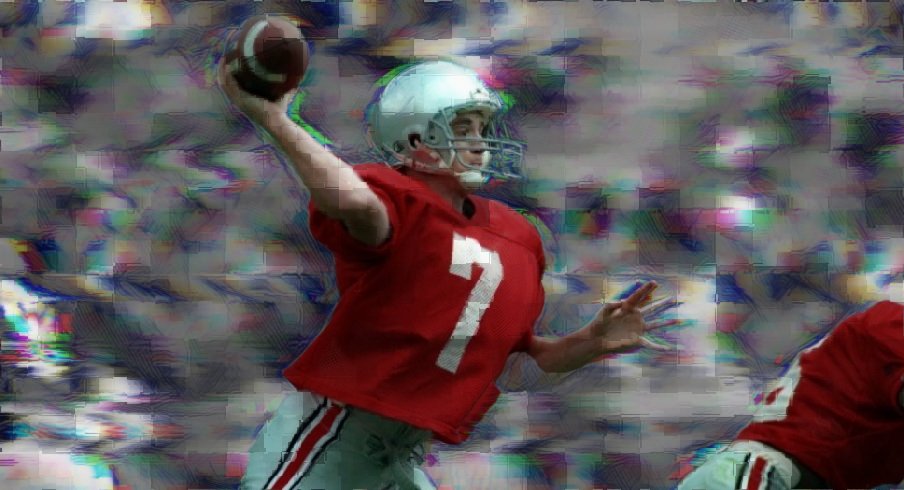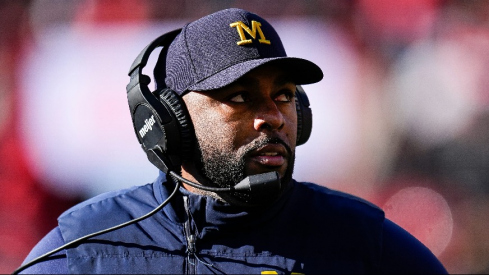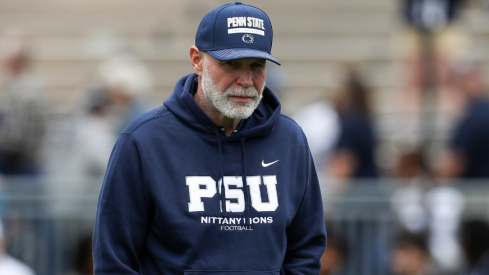Ohio State was never going to replace Eddie George.
That wasn't really the mindset, either. Buckeye fans just wanted to savor all of the parts of the 1995 season that were worth holding onto, especially Eddie running over, around and through defenses.
His Heisman campaign was the jewel of Ohio State's third-ever 11-win season. Bobby Hoying also threw bombs to the Biletnikoff winner and darts to Rickey Dudley, who pulled double-duty with the basketball team. In any other season, that would have been plenty.
The OL was big and mean and the Buckeyes hadn't been this exciting in ages. They were the greatest showmen. Keepsakes - I still have the commemorative VHS tape, but nothing to play it in - hit store shelves quickly, because the 1995 season was one for the ages.
The 1996 Buckeyes killed off the belief that rebuilding was necessary after an NFL exodus.
Eight years into the John Cooper era we knew what normal looked like, and 1995 wasn't it - outside of the final two games. We didn't know when this kind of magic would return, but we knew the follow-up couldn't possibly surpass what we had just seen.
Sure, the incoming defense was mostly intact - Damon Moore would plug in a hole a safety, Winfield Garnett was new to the DL rotation and a true freshman from Westerville was going to start at middle linebacker (and unretire Archie Griffin's no.45, the kids those days I swear) but reaching the same heights from 1995 would be next to impossible in 1996.
Those Ed-die chants that bounced around the Horseshoe were now part of history, as was Terry Glenn, the walk-on who became the sport's best receiver and whose performance in any other year would be the story of the season. He was also irreplaceable.
Anyway, college football is funny because it romances legends far more than ledgers.
| EDDIE GEORGE 1995 | PEARSON/JACKSON/WILEY 1996 | |
|---|---|---|
| CARRIES | 328 | 373 |
| YARDS | 1927 | 1979 |
| AVG | 5.9 | 5.3 |
| TOUCHDOWNS | 24 | 22 |
Pepe Pearson, Jermon Jackson and true freshman Michael Wiley effectively held serve with Eddie's production, which is an accountant's way of saying nobody chanted their names in the stadium and top line revenue was unaffected.

Not all yards or moments are created equal, but the balance sheet tells no lies. Also, the 1995 Buckeyes played one more game than the 1996 edition - so this all tracks.
| TERRY GLENN 1995 | STANLEY/BOSTON 1996 | |
|---|---|---|
| RECEPTIONS | 64 | 76 |
| YARDS | 1411 | 1279 |
| AVG | 22 | 16.8 |
| TOUCHDOWNS | 17 | 16 |
We'll get to the blips in quarter-century Buckeye football renaissance shortly, but let's drop an artifact right here: Ohio State fullback Matt Keller's 1996 receiving production would have led the team in 2011 by three receptions. That says volumes about both teams!
A fullback. Remember fullbacks? They blocked. This offense was the cruelest kind of efficient.
Eddie and Terry had been getting the ball from Bobby Hoying, who started three Michigan games (the method for measuring Ohio State QB tenures hasn't changed in 120 years). All of that passing and field general experience was with the Philadelphia Eagles in 1996.
As with Eddie and Terry, Bobby's production required a platoon.

Replacing Bobby was understudy Stanley Jackson, who had little brother Tommy, juco transfer Mark Garcia and community college transfer Joe Germaine behind him 25 springs ago. And yet, Ohio State's offensive production held steady.
It just took a village of guys throwing and passing to advance the stats and the yard markers.
| BOBBY HOYING 1995 | JACKSON/GERMAINE 1996 | |
|---|---|---|
| ATT | 341 | 312 |
| COMP | 211 | 167 |
| YARDS | 3269 | 2491 |
| AVG | 15.5 | 14.9 |
| TD/INT | 29/12 | 27/9 |
That 1996 season of trying and failing to replace Ohio State legends produced an offense that jumped from 36.5 points per game up to 37.9. A defense which had allowed 17 points per game nearly shaved a touchdown and PAT off of its average.
It became the fourth team in program history to win 11 games, the first back-to-back - and the fifth Rose Bowl champion, back when the Rose Bowl was the only thing that mattered. And, 25 years later, we can say without blushing that the 1996 Buckeyes killed off the belief that rebuilding was necessary in Columbus following an NFL exodus.

That team set in motion what is the definitive Ohio State fan culture and belief of today. In January the Buckeyes played arguably the best Alabama team ever while missing half of the defensive line, their starting running back and several other key players - and we still expected them to win.
Sure, Cardale Jones has something to do with that undying belief that anything is possible - but so does Joe Germaine. So does David Boston. So does Michael Wiley. So does Pepe Pearson, the only one of those four who was actually on the 1995 team.
The seasons since 1996 have provided their share of blips, but nothing resembling a downturn - which makes it unique across the entire Football Subdivision. The 1999 Buckeyes struggled, but had players who were part of the 1996-98 teams as well as the 2002 BCS champions.
That 2004 edition lost three straight (including the only loss to Northwestern in 50 years) but won its last two and played exclusively in BCS-tier bowl games going forward. Even the 2011 self-nuke season following Jim Tressel's departure contained future national champions.
Every blip since 1996 has held the catalyst for future greatness. Those who stay will be champions is a bumper sticker at other programs. It's been testimony at Ohio State for 25 years and five coaches.
Buckeye fans take garden-variety Buckeye wins for granted today because there are so many of them. The 1996 team was the 9th ever to win double-digit games; the 2019 team was the 28th.
Our entitlement began long before most of us arrived, when coaches were being run out of town for not winning enough. But that entitlement was justified and solidified in 1996 when Ohio State replaced a legendary team with true freshmen and a community college transfer en route to winning the Rose Bowl.
The Buckeyes began to become who they are today because of what they pulled off 25 years ago, and that should bring some comfort this spring as Ohio State evaluates which quarterback - none of which have ever thrown a collegiate pass - will take the reins of the offense this fall.



